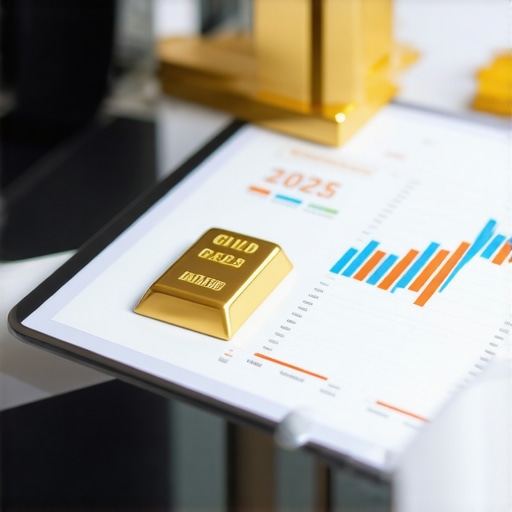Unlocking the Power of Gold ETFs for Portfolio Diversification
In today’s volatile financial landscape, investors are increasingly seeking resilient assets that can cushion against market swings and inflationary pressures. Gold Exchange-Traded Funds (ETFs) emerge as a compelling instrument, blending the timeless allure of gold with the liquidity and accessibility of stock market investments. But how exactly can savvy investors incorporate gold ETFs to construct a truly diversified portfolio that withstands economic turbulence? This article delves deep into expert strategies and practical insights that elevate your investment approach beyond surface-level tactics.
Strategic Gold ETF Allocation: Balancing Risk and Reward
Integrating gold ETFs into your portfolio isn’t merely about adding a shiny metal asset; it’s about leveraging gold’s unique market behavior to optimize risk-adjusted returns. Historical data from sources like the World Gold Council illustrates that gold often exhibits negative or low correlation with equities and bonds, making it an effective hedge during market downturns. Allocating between 5% to 15% of your portfolio to gold ETFs can reduce overall volatility without sacrificing growth potential. However, this allocation should be tailored to your individual risk tolerance, investment horizon, and financial goals.
How Do Gold ETFs Compare to Physical Gold and Other Investment Vehicles?
While physical gold offers tangible security, it comes with storage, insurance, and liquidity challenges. Gold ETFs circumvent these hurdles by providing exposure to gold prices without the need for physical possession, allowing investors to buy and sell shares with the ease of stocks. Compared to mutual funds or gold mining stocks, gold ETFs typically offer lower expense ratios and more direct correlation to gold prices. However, investors should remain mindful of management fees and the ETF’s structure, as some use futures contracts which may introduce tracking errors.
Practical Steps to Integrate Gold ETFs Into Your Investment Framework
First, select reputable gold ETFs that align with your investment philosophy—consider funds like SPDR Gold Shares (GLD) or iShares Gold Trust (IAU), which have significant assets under management and transparent holdings. Next, determine the timing of entry by analyzing gold price trends, geopolitical events, and economic indicators such as inflation rates and central bank policies. Diversify your ETF holdings by mixing pure gold ETFs with those investing in gold mining companies to blend direct commodity exposure with growth potential. Lastly, consistently rebalance your portfolio to maintain your desired allocation, especially during periods of heightened market volatility.
Beyond Diversification: Harnessing Gold ETFs as an Inflation Hedge
Gold has historically functioned as a robust hedge against inflation, preserving purchasing power when fiat currencies weaken. In contemporary markets marked by expansive monetary policies and supply chain disruptions, gold ETFs provide investors with scalable access to this protective asset. Incorporating gold ETFs strategically can help safeguard portfolio value during inflationary spikes, complementing other inflation-sensitive assets like real estate or Treasury Inflation-Protected Securities (TIPS).
Expert Insight: Navigating Gold Demand Trends to Maximize ETF Benefits
Understanding the dynamics driving gold demand enhances your ability to anticipate price movements and optimize your investment timing. Factors such as central bank acquisitions, jewelry demand, and technological applications influence supply and demand balances. For a deeper dive into these market forces, consult detailed analyses like the comprehensive report on global gold demand trends and their market impact. Armed with this knowledge, you can position your gold ETF investments to capitalize on emerging opportunities and mitigate risks.
Share Your Gold ETF Experiences and Questions
Have you integrated gold ETFs into your investment portfolio? What strategies worked best for you, and what challenges did you encounter? Join the conversation by leaving a comment below—your insights could be invaluable to fellow investors navigating the gold investment landscape.
Lessons Learned: Common Pitfalls When Investing in Gold ETFs
From my journey navigating the gold investment world, I quickly realized that even a seemingly straightforward vehicle like gold ETFs has nuances that can trip up unsuspecting investors. One classic mistake I made early on was overlooking the structure of the ETF itself. Some ETFs use futures contracts or derivatives to track gold prices, which can lead to tracking errors especially in volatile markets. This subtle difference affected my returns initially and taught me to scrutinize fund prospectuses more carefully.
Moreover, I underestimated the importance of considering expense ratios. While gold ETFs generally have lower fees than mutual funds, those small percentages compound over time and can significantly impact long-term performance. It’s worth comparing options like popular gold ETFs and physical gold dealers to determine what fits your strategy best.
Personalizing Your Gold ETF Mix: Beyond Just Holding Gold
As I gained confidence, I experimented with blending pure gold ETFs with those investing in gold mining stocks. This approach added an interesting growth dimension to my portfolio, since mining stocks can outperform gold bullion when market conditions favor them. However, mining stocks also bring higher volatility and company-specific risks. Balancing these was a learning curve, but ultimately it diversified my exposure effectively.
For fellow investors curious about this blend, consider reading up on top gold investment strategies tailored for volatile markets. Tailoring your allocation depends heavily on your risk profile and market outlook.
What Are the Real-World Triggers That Can Shake Gold ETF Prices?
This question often pops up in my discussions with friends new to gold investing. Beyond the usual suspects like inflation and currency fluctuations, geopolitical tensions, central bank gold purchases, and even shifts in technology demand for gold can cause price swings. For instance, the recent surge in green technology has lifted demand for gold in electronics, impacting supply dynamics.
According to a recent analysis by the World Gold Council, central bank buying has been a significant driver of gold price resilience in uncertain times. Understanding these triggers helps in timing your entry and exit points better, turning gold ETFs from mere passive holdings into strategic portfolio levers.
Engage and Expand Your Gold Investment Insights
Have you encountered unexpected lessons while investing in gold ETFs or physical gold? What strategies have you found most effective in balancing risk and reward? Feel free to share your experiences or ask questions in the comments below—we can all benefit from diverse perspectives. And if you want to explore more about safely acquiring physical gold, check out this comprehensive guide to buying gold bullion safely. Let’s continue this journey of smart and secure gold investing together!
Decoding the Impact of Monetary Policy on Gold ETF Performance: A Sophisticated Analysis
Monetary policy decisions by central banks profoundly influence gold prices and, consequently, gold ETFs. Quantitative easing, interest rate adjustments, and currency interventions can create ripple effects that either bolster or undermine gold’s appeal as a safe-haven asset. For instance, near-zero or negative real interest rates often enhance gold’s attractiveness by reducing the opportunity cost of holding non-yielding assets. Conversely, tightening cycles with rising rates can pressure gold prices as investors seek yield-bearing instruments.
Investors aiming to capitalize on these dynamics should monitor Federal Reserve communications, European Central Bank policies, and emerging market central bank actions. Incorporating macroeconomic indicators such as the Taylor Rule estimates or yield curve inversions into your analysis can provide early signals for tactical allocation adjustments within gold ETFs.
How Can Sophisticated Investors Mitigate Tracking Errors in Gold ETFs?
Tracking error presents a subtle but critical challenge in gold ETF investing, especially for sophisticated portfolios targeting precision exposure. ETFs that rely heavily on futures contracts rather than physical gold backing may experience divergence from spot gold prices due to roll costs, contango, or backwardation in futures markets. To mitigate this, investors can:
- Choose physically-backed gold ETFs with transparent holdings and audited reserves, reducing counterparty risk and tracking discrepancies.
- Employ a multi-ETF strategy combining both physical and futures-based ETFs to balance liquidity and cost considerations.
- Utilize advanced portfolio management tools to monitor and rebalance based on real-time tracking deviations.
Academic research, such as that published in the CFA Institute’s detailed analysis on ETF tracking error, underscores the importance of these approaches for optimizing gold ETF performance.
Integrating Gold ETFs into Algorithmic Trading Models for Enhanced Portfolio Resilience
As algorithmic trading and quantitative strategies dominate modern portfolio management, integrating gold ETFs into algorithm-driven models can add a robust inflation and crisis hedge. By incorporating gold ETFs as a volatility dampener or as part of multi-factor risk parity models, investors can exploit its low correlation with equities and bonds.
Machine learning techniques—such as reinforcement learning or regime-switching models—can dynamically adjust gold ETF weightings based on predictive signals like geopolitical risk indices or macroeconomic shocks. This not only enhances portfolio resilience but also uncovers alpha-generating opportunities beyond static allocation frameworks.
For practitioners, leveraging platforms that provide granular intraday gold price data and ETF liquidity metrics is vital to calibrate these models effectively.
Advanced Tax Implications and Structuring Considerations for Gold ETF Investors
Tax treatment of gold ETFs varies significantly by jurisdiction and ETF structure, presenting opportunities and pitfalls for sophisticated investors. In the United States, for example, gains from gold ETFs backed by physical bullion are often taxed as collectibles at a higher rate than standard capital gains. Conversely, ETFs structured as grantor trusts may pass through tax implications differently than futures-based ETFs.
International investors should also consider withholding taxes, VAT, and local securities regulations when selecting gold ETFs. Strategic tax-loss harvesting and timed divestments around expected inflation announcements can optimize after-tax returns.
Consulting with tax professionals who specialize in precious metals investment is paramount to designing an efficient gold ETF investment plan aligned with your broader financial goals.
Invitation to Explore Deeper Insights and Share Expertise
The sophisticated terrain of gold ETF investing rewards continuous learning and dialogue. Have you developed proprietary models or unique strategies to integrate gold ETFs into your portfolio? What nuanced challenges have you navigated regarding tracking errors or tax structuring? Share your experiences and questions below to enrich our collective expertise.
For those eager to deepen their understanding, consider exploring the World Gold Council’s latest report on central bank gold reserves and market implications—a cornerstone resource for informed investment decisions.
Deciphering Gold ETF Liquidity and Market Depth for Tactical Advantage
Liquidity considerations often fly under the radar yet are pivotal when trading gold ETFs, especially under volatile market conditions. High liquidity ensures tight bid-ask spreads, minimizing transaction costs and slippage. Institutional investors and algorithmic traders frequently scrutinize market depth data to identify optimal execution windows and avoid exacerbating price impact. ETFs like SPDR Gold Shares (GLD) and iShares Gold Trust (IAU) typically exhibit robust liquidity; however, niche or leveraged gold ETFs may experience sporadic volume fluctuations, warranting cautious entry and exit strategies.
How Can Investors Quantify and Monitor Liquidity Risks in Gold ETFs?
Quantifying liquidity risk entails analyzing metrics such as average daily traded volume, bid-ask spreads, and the ETF’s underlying asset liquidity. Sophisticated investors deploy tools like the Amihud illiquidity ratio or Kyle’s lambda to capture price impact per unit volume. Real-time market data platforms can alert to sudden liquidity contractions that precede volatility spikes. By proactively monitoring these indicators, investors can adjust position sizes or stagger trades to mitigate adverse execution costs.
Leveraging Derivatives Overlay with Gold ETFs for Customized Exposure
Advanced portfolio managers sometimes augment gold ETF holdings with derivatives overlays—options, futures, or swaps—to sculpt bespoke risk-return profiles. For instance, purchasing gold call options while holding ETFs can provide leveraged upside with defined downside risk. Conversely, writing covered calls on gold ETFs may generate incremental income in flat markets. Such tactical overlays require meticulous understanding of derivatives Greeks and margin implications, underscoring the need for expertise or advisory collaboration.
Gold ETF Counterparty and Custodial Risks: An Underestimated Dimension
While gold ETFs are often lauded for mitigating physical gold custody challenges, they introduce counterparty and custodial risks embedded in their structural mechanics. Physically-backed ETFs rely on custodians to securely store bullion, necessitating rigorous audits and transparent reporting. Futures-based ETFs expose investors to counterparty credit risk inherent in derivative contracts, which can be mitigated through collateralization and clearinghouse guarantees. Due diligence on the ETF provider’s operational integrity and insurance frameworks is indispensable for risk-averse investors.
According to the U.S. Securities and Exchange Commission’s guidance on ETF risks, awareness of these nuances is critical for informed decision-making.
Enhancing Gold ETF Integration with ESG and Sustainable Investing Criteria
As Environmental, Social, and Governance (ESG) considerations permeate investment paradigms, some gold ETFs now incorporate sustainability factors, focusing on responsible mining practices and ethical sourcing. Investors aiming to align portfolios with ESG principles may opt for ETFs screening mining companies for carbon footprint, human rights adherence, and governance standards. This emerging niche not only addresses ethical imperatives but may also attenuate regulatory or reputational risks associated with traditional gold investments.
Invitation to Engage: Share Your Advanced Gold ETF Methodologies and Queries
Have you deployed liquidity analytics or derivatives overlays to refine your gold ETF strategy? What frameworks have you employed to assess and manage counterparty exposures or integrate ESG mandates? Join our expert community by sharing your sophisticated approaches and questions below. For those wishing to deepen their technical foundation, the CFA Institute’s comprehensive ETF tracking error analysis offers invaluable insights to elevate your investment acumen.

Frequently Asked Questions (FAQ)
What are Gold ETFs and how do they differ from owning physical gold?
Gold ETFs are exchange-traded funds that track the price of gold, allowing investors to gain exposure to gold prices without holding physical bullion. Unlike physical gold, gold ETFs offer liquidity, ease of trading, and eliminate storage or insurance concerns. However, they may carry management fees and, depending on structure, can have tracking errors especially if based on futures contracts rather than physical holdings.
How much of my investment portfolio should I allocate to gold ETFs?
Experts typically recommend allocating between 5% and 15% of your portfolio to gold ETFs to balance diversification benefits and risk. The exact allocation depends on your risk tolerance, investment horizon, and market outlook. Gold’s low correlation with equities and bonds makes it a valuable hedge, but overexposure can limit growth potential.
What factors influence the price fluctuations of gold ETFs?
Gold ETF prices are influenced by the underlying gold price, which responds to inflation trends, monetary policy shifts, geopolitical tensions, central bank activities, and demand from industries such as jewelry and technology. Additionally, ETF-specific factors like tracking error, liquidity, and fund management can impact price performance.
Are physically-backed gold ETFs safer than futures-based gold ETFs?
Physically-backed gold ETFs hold actual gold bullion, which reduces counterparty risk and tracking errors, making them generally safer for investors seeking direct gold exposure. Futures-based ETFs rely on derivative contracts and may experience tracking discrepancies due to contango or roll costs, requiring sophisticated monitoring.
How do tax considerations affect gold ETF investments?
Tax treatment varies by jurisdiction and ETF structure. In the U.S., gains from physically-backed gold ETFs may be taxed as collectibles at a higher rate, while futures-based ETFs can have different capital gains implications. International investors must also consider withholding taxes and local regulations. Consulting a tax advisor familiar with precious metals is advisable for optimal planning.
Can gold ETFs be used effectively in algorithmic trading strategies?
Yes, gold ETFs can be integrated into algorithmic and quantitative models to improve portfolio resilience and hedge inflation or crisis risks. Advanced models may dynamically adjust allocations based on macroeconomic signals, geopolitical risk indices, or volatility patterns, enhancing alpha generation beyond static allocations.
What liquidity risks should investors be aware of when trading gold ETFs?
Liquidity risks include wide bid-ask spreads, low trading volume, and market depth constraints, especially in niche or leveraged gold ETFs. Monitoring average daily volume, bid-ask spreads, and real-time liquidity metrics helps investors minimize transaction costs and avoid price slippage during volatile periods.
How can investors mitigate tracking errors in gold ETFs?
To mitigate tracking errors, investors should prefer physically-backed ETFs with transparent holdings, consider diversifying across ETFs with different structures, and regularly rebalance portfolios. Utilizing portfolio management tools to monitor deviations in real time also helps maintain alignment with underlying gold prices.
What are the counterparty and custodial risks associated with gold ETFs?
Physically-backed ETFs depend on custodians to securely store gold, posing custodial risk mitigated by audits and insurance. Futures-based ETFs carry counterparty risk related to derivative contracts, which can be reduced through collateralization and clearinghouse guarantees. Due diligence on the ETF provider’s operational integrity is essential.
How do ESG considerations impact gold ETF investing?
Some gold ETFs incorporate ESG criteria by selecting mining companies with responsible environmental practices, social responsibility, and strong governance. This can reduce regulatory and reputational risks while aligning investments with ethical values, appealing to sustainability-conscious investors.
Trusted External Sources
- World Gold Council – Offers authoritative research on gold demand, supply, and central bank buying trends, essential for understanding macro drivers affecting gold ETF performance.
- CFA Institute – Provides in-depth analyses on ETF tracking errors and portfolio management techniques, invaluable for sophisticated investors optimizing gold ETF allocations.
- U.S. Securities and Exchange Commission (SEC) – Publishes guidelines on ETF risks, including counterparty and custodial considerations, helping investors make informed decisions.
- Financial Times and Bloomberg – Deliver up-to-date market data, liquidity measures, and geopolitical insights impacting gold markets and ETFs.
- Academic Journals on Financial Economics – Present rigorous research on algorithmic trading integration and derivative overlays with gold ETFs, supporting advanced portfolio strategies.
Conclusion
Gold ETFs present a versatile and accessible avenue to incorporate gold’s unique risk-mitigating properties into diversified portfolios. By understanding their structure, market drivers, and tax implications, investors can strategically allocate gold ETFs to enhance resilience against inflation, market volatility, and geopolitical uncertainties. Employing sophisticated techniques—such as monitoring liquidity, mitigating tracking errors, integrating algorithmic models, and considering ESG factors—further refines investment outcomes. Whether you are a novice seeking stable diversification or an expert managing complex portfolios, informed gold ETF investment can be a cornerstone of financial strategy. Share your experiences, engage with our expert community, and explore further resources to harness the full potential of gold ETFs in your portfolio today.










